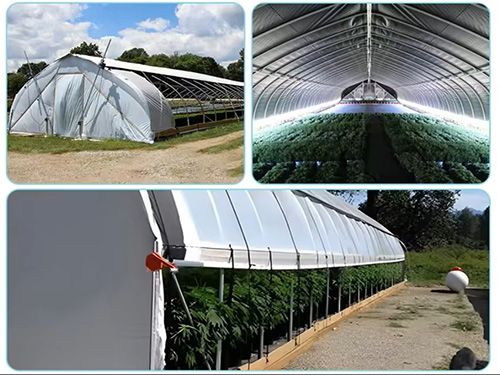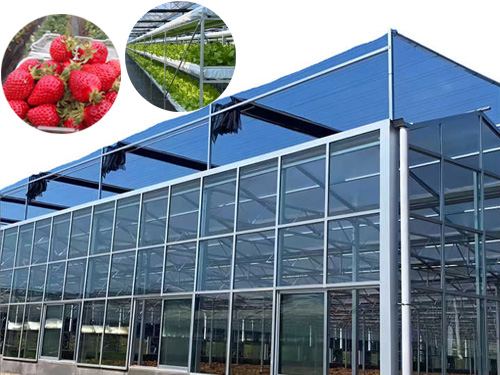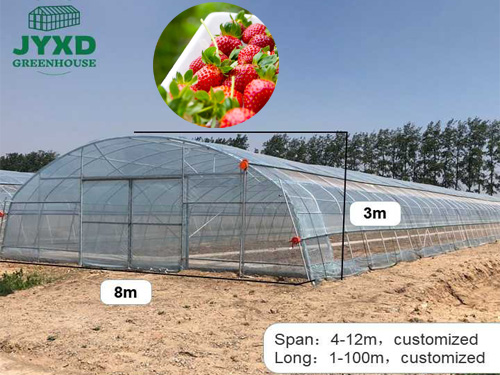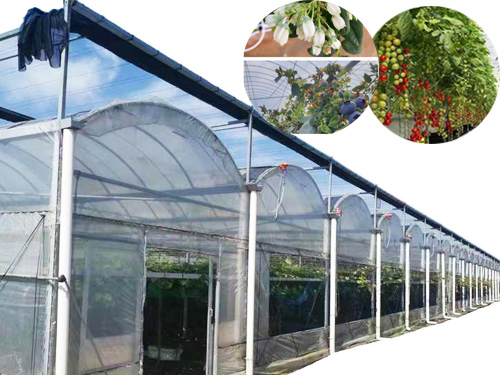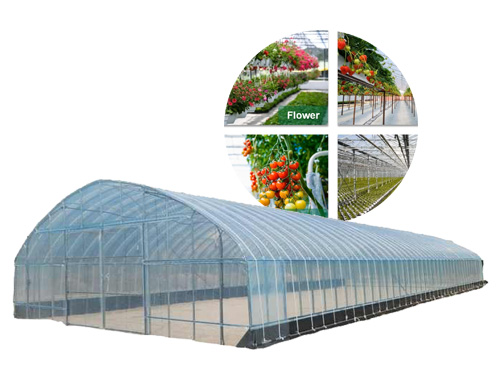NEWS DETAILS
NEWS INFORMATION
Urban Greenhouses: Optimizing Space in Dense Urban Environments
AUTHOR:jyxd-greenhouse DATE:2025-01-21 17:03:48 HITS:138
Urbanization continues to rise globally, leading to increasingly crowded cities where traditional agriculture struggles to thrive. However, urban greenhouses present a promising solution to this challenge. By utilizing available urban space to grow fresh produce, urban greenhouses not only contribute to local food production but also support sustainability in densely populated areas. This article explores the concept of urban greenhouses, how they optimize limited space, and the benefits they bring to cities and communities.
The Rise of Urban Greenhouses
Urban greenhouses are becoming a key part of urban agriculture, particularly in cities where traditional farming space is limited. These greenhouses are typically built in urban environments such as rooftops, vacant lots, or even on the sides of buildings, transforming underused spaces into productive areas for growing food.
As cities grow and available land becomes scarce, the integration of greenhouses within urban settings has been identified as an effective method of utilizing space more efficiently. These innovative farming solutions make use of the vertical dimension, often using hydroponic or aeroponic growing methods, which allow crops to be grown in smaller, confined spaces without the need for large plots of land.
Advantages of Urban Greenhouses
Urban greenhouses provide numerous benefits that enhance food security, environmental sustainability, and urban livability. Here are some key advantages of integrating greenhouses into urban areas:
1. Maximizing Limited Space
In dense urban environments, space is at a premium. Traditional farming requires large swathes of land, which is often unavailable in metropolitan areas. Urban greenhouses, however, utilize small spaces efficiently by growing crops vertically or using advanced growing techniques like hydroponics and aquaponics. This allows for the cultivation of a wide variety of crops, even in areas with limited square footage.
· Rooftop Greenhouses: These greenhouses take advantage of unused rooftop space, providing opportunities to grow food without occupying valuable ground-level land.
· Vertical Farming: Vertical farming methods enable the cultivation of crops on stacked layers, optimizing vertical space and increasing production within the same footprint.
2. Fresh, Locally Grown Produce
Urban greenhouses help reduce the need for transportation of food, as produce is grown locally within city limits. This results in fresher, healthier food options for urban residents and reduces the carbon footprint associated with long-distance food transport. Additionally, urban greenhouses can grow crops year-round, providing a consistent and reliable source of fresh produce, even in urban environments where growing seasons are limited.
3. Sustainability and Environmental Benefits
Urban greenhouses are an eco-friendly solution for cities looking to become more sustainable. They contribute to environmental conservation by reducing food miles, minimizing the use of chemical pesticides and fertilizers, and promoting resource efficiency.
· Water Efficiency: Many urban greenhouses utilize water-efficient systems, such as hydroponics and aquaponics, which use significantly less water compared to traditional farming methods.
· Energy Conservation: Some greenhouses use renewable energy sources like solar panels to power their operations, further reducing their environmental impact.
· Reducing Urban Heat Islands: Greenhouses on rooftops or in urban spaces help mitigate the heat island effect by absorbing sunlight and reducing the amount of heat that is radiated from impervious surfaces.
4. Improving Food Security
Urban greenhouses contribute to food security by providing cities with the ability to grow their own food, reducing dependency on external sources. This is particularly important in regions that face challenges with food supply chains, such as during natural disasters or supply chain disruptions. Urban greenhouses also help to provide fresh, nutritious food to areas with limited access to grocery stores or fresh produce.
Techniques for Optimizing Space in Urban Greenhouses
To make the most of limited urban space, various techniques can be employed to maximize productivity and efficiency in greenhouse environments. These techniques allow for high yields in compact spaces and offer solutions for growing in challenging conditions.
1. Hydroponics and Aeroponics
Hydroponics and aeroponics are soil-free growing systems that are ideal for urban greenhouses. These methods involve growing plants in a nutrient-rich water solution (hydroponics) or in the air, where the roots are misted with nutrients (aeroponics). Both systems allow for dense plant growth without the need for traditional soil, which can take up significant space and require large amounts of water.
· Hydroponics: By growing plants in water with dissolved nutrients, hydroponic systems provide more efficient nutrient absorption and allow for faster plant growth.
· Aeroponics: This method, which uses mist to feed plant roots, requires less water and space, making it particularly suited for vertical farming systems.
2. Vertical Farming Systems
Vertical farming involves stacking layers of crops on top of each other, making the most of the vertical space in a greenhouse. This technique enables urban farmers to grow large quantities of produce without taking up a significant amount of ground-level space. Vertical farming systems can be designed as multi-story structures or as compact, modular units that can be adapted to different types of urban environments.
· Modular Racking Systems: These systems feature rows of plants stacked vertically, with automated systems for watering and nutrient delivery.
· LED Grow Lights: Artificial lighting, such as energy-efficient LEDs, is used to supplement natural sunlight and provide crops with the necessary light for photosynthesis, even in low-light conditions or during the winter months.
3. Greenhouse Integration into Urban Infrastructure
Integrating greenhouses into existing urban infrastructure can maximize space efficiency. For instance, urban greenhouses can be built into the facades of buildings, on parking lots, or in vacant urban spaces. This strategy transforms underutilized or unused spaces into productive areas for growing food.
· Building-Integrated Agriculture (BIA): This approach incorporates farming directly into building design, such as integrating vertical greenhouses on the sides of buildings or incorporating green roofs into new construction projects.
· Community Greenhouses: Shared greenhouses in urban areas can be used by local communities to grow food collectively, creating communal spaces for food production and promoting food sovereignty.
Challenges of Urban Greenhouses and Solutions
While urban greenhouses offer significant benefits, they also face certain challenges that need to be addressed for long-term success. Some of these challenges include:
1. Space Constraints
Although urban greenhouses optimize available space, cities still have limited land for expansion. To overcome this, greenhouse projects need to be well-planned and may require creative solutions such as rooftop farming, vertical farming, or integrating greenhouses into existing buildings.
2. Cost of Setup and Maintenance
The initial cost of setting up an urban greenhouse can be high, especially for more advanced systems like hydroponics or aeroponics. To mitigate these costs, urban farmers can seek financial support from government programs, grants, or crowdfunding campaigns. Additionally, collaboration with local businesses or organizations can help spread the costs and improve the greenhouse’s profitability.
3. Regulatory and Zoning Issues
Urban farming projects often face challenges with zoning laws and regulations that may restrict the use of certain urban spaces for agricultural purposes. Engaging with local governments and advocating for policy changes can help create more supportive environments for urban greenhouses.
Conclusion
Urban greenhouses represent an innovative solution for growing fresh produce in cities with limited space. By optimizing space through vertical farming, hydroponics, and integrating greenhouses into urban infrastructure, cities can promote sustainability, increase food security, and provide healthier food options for residents. While challenges exist, the benefits of urban greenhouses make them a valuable investment in the future of urban agriculture, and their continued growth will play a crucial role in building more resilient, sustainable cities.
Hebei Juyou Xinda Greenhouse Facilities Co.,Ltd.
Copyright © 2024-2025 https://www.jyxd-greenhouse.com. All Rights Reserved Hebei Juyou Xinda Greenhouse Facilities Co.,Ltd.Copyright





 Current Location:
Current Location:


